How to create a B2B sales funnel: 10 case studies

Sales funnels are essential for lead generation, and brand websites should be built considering the stages prospects go through until they are primed to buy.
Every lead gains awareness of their problems, considers the available solutions, and finally makes an informed purchase in their buying journey. And it is possible to design your website to cater to these three steps and as a result, gain more conversions.
In this case study article, we analyze the websites of 10 brands and how their content marketing assets fit into the top (TOFU), middle (MOFU), and bottom (BOFU) of the sales funnel.
Each brand has a list of pros and cons, and we present our final thoughts at the end of the article on what makes a good lead funnel for a B2B website.

#1 Cisco
Telecommunications giant Cisco has a sales funnel with several entry points, allowing visitors to pinpoint a specific need and delve deeper.
In a specialized industry with an educated audience, Cisco hits the nail on the head by allowing prospects that desire in-depth content to find it quickly—while beginners can learn the basics with generalist guides right from the homepage.
Awareness (TOFU)
For its top of the funnel marketing, Cisco provides guides under “I need to” sections of its Products tab.
As you can see, the links vary from the general, such as “help enable work-from-home”, to the complex, as in “upgrade to Wi-Fi 6.”
The links lead to comprehensive guides with benefits, videos, product demos, and CTAs to finance the solution or speak to an advisor.
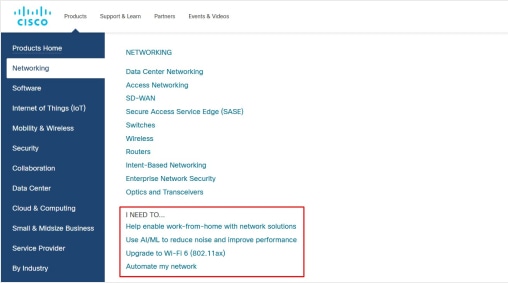
Homepage entry points
In case the user scrolls down and ignores the top bar, Cisco offers a second navigation bar with icons for top of funnel leads:

And then Cisco mixes up top, middle, and bottom of the funnel with the featured stories at the end of the homepage. There are case studies, solutions, eBooks, and videos.
Thus, from a TOFU perspective, Cisco provides an array of possibilities for the visitor to learn more about solutions to their networking problems, whitout being rigid or forcing them down a certain path.
Consideration (MOFU)
By using the same navigation bar as described above for its middle of funnel, users can explore the “top products” or get a free trial for the solution they are considering.
Under some solutions, Cisco outlines the “most popular”, guiding prospects towards the most requested products and reducing choice anxiety.
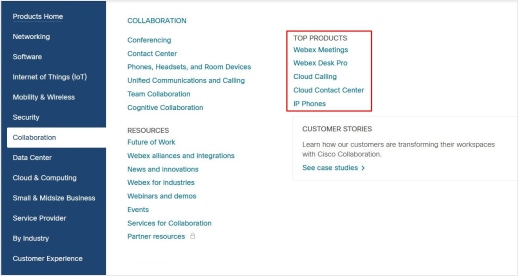
And as you can see from the screenshot in the top-right, Cisco also links to Customer Stories (case studies), on several industries—from filmmaking to the energy sector.
The case studies feature videos, a summary, a quote by the client, and their company information.
While the copy is short, Cisco makes up for it in production value. The videos are of superb quality with captivating images and client interviews.
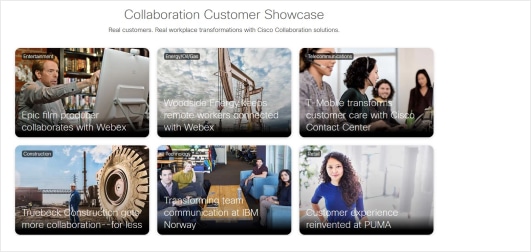
Decision (BOFU)
For the bottom of the funnel, Cisco uses analyst research and webinars and demos.
The analyst research features independent studies by Gartner, Aragon, and Forrester on Cisco products, providing not only credibility, but also a chance to get lead information. Each report requires the visitor to fill in their name, company, and country, allowing Cisco to get in touch with a Sales Development Representative (SDR) for a free demo.
The same applies to the Webinar section, with on-demand content, online classes, and “ask the expert” consultations. In fact, Cisco only asks for lead information for its BOFU assets.
Pros and Cons
Cisco provides enough leeway for middle and bottom of the funnel prospects to learn about the company with reports, case studies, and “I need to” guides.
Pros
- Many entry points: Cisco allows its wide target audience to navigate freely through its product pages, making the discovery of solutions simple and not “enforced” by a static, one-page funnel.
- Brilliant case study videos: The videos are of great quality and perfect for email and social media marketing. Many short clips with impactful quotes can be extracted from these videos for Instagram and YouTube ads, for example.
- Independent reports and on-demand webinars: Reports by Gartner and Forrester provide credibility since they are performed by a reputable, independent entity. And the on-demand content features Cisco experts discussing future work trends in telecommunications.
Cons
- Ungated case studies: While to gate content or not is a choice every digital marketer must face, in Cisco’s case, ungating case studies means losing out on MOFU/ BOFU leads. However, this can be a strategic choice by the company to focus on lead generation from analyst reports and webinars.

#2 Samsung Business
Hardware and software giant Samsung has a homepage for its B2B audience with dedicated pages per vertical to segment prospects.
Awareness (TOFU)
On its homepage, Samsung filters prospects with the “Business solutions tailored for your industry” header, alongside icons to check industry-specific solutions.
Each page lists the solutions, products, case studies, and insights/resources on technology for that sector.
By funneling out the prospects into specific industry tracks, Samsung Business makes it easier to qualify leads and nurture them with relevant content. After all, the needs of a headmaster are different from a finance analyst.
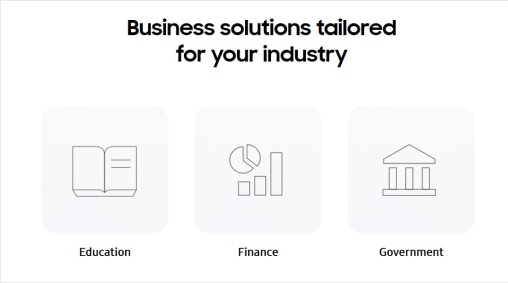
Business resources and insights
At the end of the homepage, Samsung links to case studies and blog posts for TOFU/ MOFU leads.
The content pertains to several industries, such as 4 tips for SMBs to get maximum volume from mobile and a Walmart case study. Thus, Samsung Business mixes up stages of the lead funnel with leeway for visitors to navigate smoothly as desired from one step to another.
Consideration (MOFU)
Besides the resources section at the bottom of the homepage, Samsung also offers an “Integrated Business Solutions” section geared towards middle of funnel leads.
The solutions are split into categories such as Security & Services, Remote Work, and Advertising.
Solutions change as the user picks a category, making it easy to find what they identify with the most. And each solution has its own web page, providing more details on its benefits with links to whitepapers, videos, ratings, and case studies.
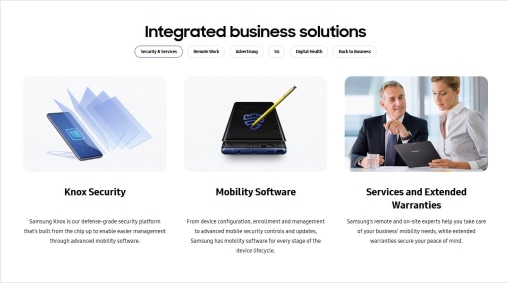
Decision (BOFU)
Samsung has an offers section for bottom of the funnel leads. With a 30% discount on bulk orders and savings of up to $800 for trade-ins, Samsung demonstrates how businesses that shop its products are saving a lot of money.

Each offer links to another page, which explains its conditions and a CTA to shop/apply.
After clicking the CTA, the user is prompted to create a Samsung Business account and thus become a lead and enter its nurturing ecosystem of offers and content.
Pros and Cons
With a simple homepage, Samsung Business allows prospects at any stage of the lead funnel to quickly learn more about the brand. However, it leans more towards salesy than informational.
Pros
- Easy-to-view offers: For leads that would rather cut to the chase, Samsung makes it easy to find the product you’re looking for in just a few clicks.
- Audience-segmented tracks: By creating web pages geared towards each industry, Samsung Business can identify the user and promote the most recommended solutions for their needs. It’s also user-friendly, making it easy to view what’s most relevant.
Cons
- Mismatch between gated and ungated content: Some case studies are gated, while others aren’t, without a clear reason. Instead of a mismatch, it would be best to organize the assets and decide whether to gate all of them or not.

#3 Salesforce
Customer Relationship Management (CRM) champion Salesforce shows a great example of how to structure your website as a sales funnel primed for conversion.
Awareness (TOFU)
For its top of the funnel marketing, Salesforce allows prospects to navigate products “by need” or “by industry”, which allows the user to discover the brand with what they care about most.
And in case the user scrolls down, they have access to resources that educate them, such as a CRM starter pack, an industry guide, and a buyer's guide. These assets are built intentionally to educate users with little knowledge of CRM software.
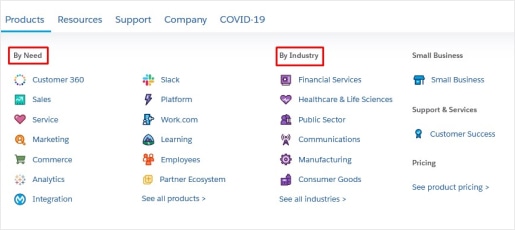
Blog and guides
Salesforce has a thriving content ecosystem with guides and think pieces for top of funnel leads.
Educational pieces such as What is CRM? and What Does Salesforce Do? are geared towards awareness and consideration-stage prospects, explaining how their services work and their benefits to productivity and ROI.
Consideration (MOFU)
For middle of funnel leads considering solutions, Salesforce provides webinars, research, and case studies on how its services improve customer management.
While there are some content highlights on the homepage (as well as the blog), all these assets can be conveniently accessed via the resources tab at the top bar.
And the amount of content is staggering: there are several analyst reports, how-to guides, and webinars/videos to watch.
To make sense of this wealth of content, Salesforce features some recommendations at the top of each resources subpage, as in the screenshot below:
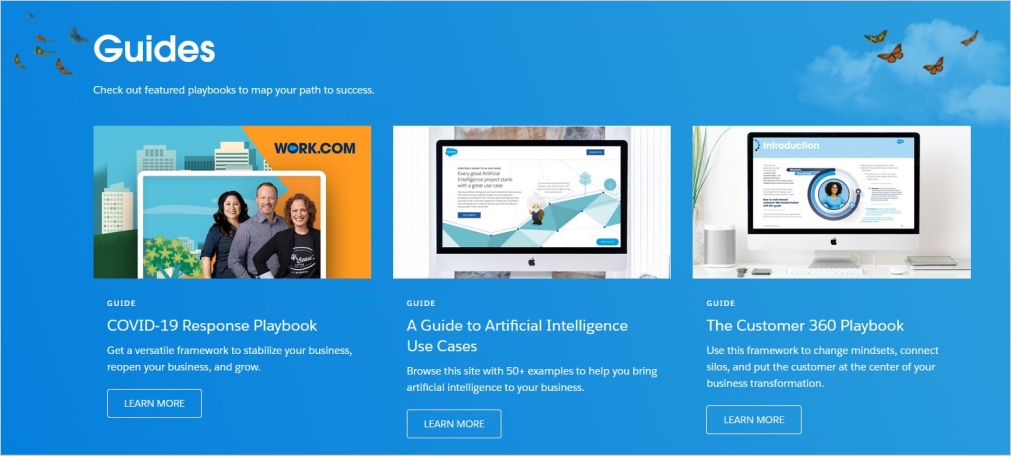
Decision (BOFU)
Salesforce’s webinars are its BOFU-oriented content, with highly specific, on-demand assets such as Simplifying the Complexity of Cross-Channel Advertising Sales and The ROI of Creating Customer Experiences on Salesforce Platform with Heroku.
As evidenced by the titles, you can see this content is for prospects that are very knowledgeable and looking for further insights from experts. Also, Salesforce demonstrates authority by hosting webinars with marketing leaders, including Forrester and Neil Patel.
Case studies
Right on the homepage, Salesforce features a customer story, which changes from time to time to highlight a different client (at the start of writing this article it was Jet It, and in a week it changed to Headspace).
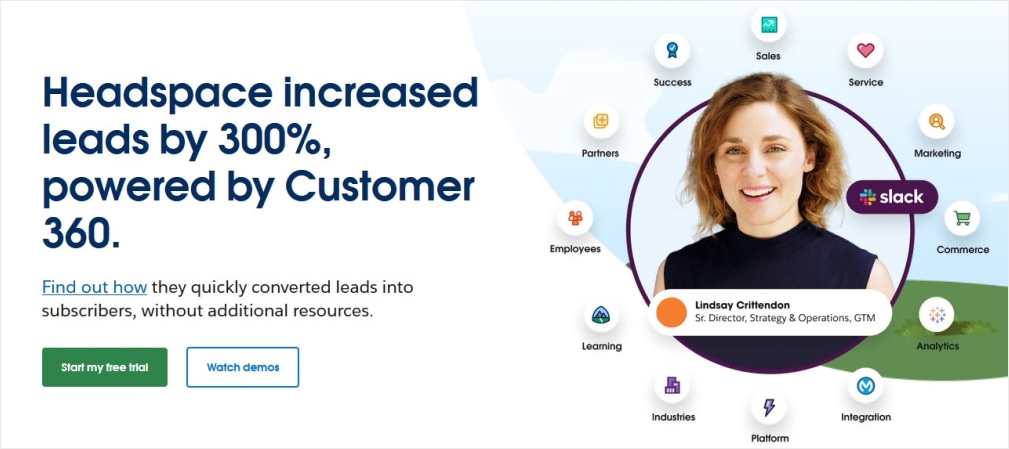
Some of Salesforce’s customer stories are gated, while others aren’t, and they combine infographics, videos, and copy in engaging, multimedia assets. And at the bottom of the case studies, Salesforce links to similar clients, providing even more credibility on how the brand can solve an issue for several companies.
Brand evangelist content
Salesforce hosts Dreamforce, an annual event with clients, marketing experts, and employees to discuss innovation in CRM software.
With this event (held virtually in 2021), the brand positions itself as a thought leader, while also retaining clients as evangelists, who seek to go to this experiential marketing experience.
Pros and Cons
Salesforce has a plethora of assets and an easy-to-navigate website for visitors at any stage of the sales funnel.
Pros
- Unique content: Salesforce has a treasure trove of creative content. Thus, it has plenty of shareable assets to generate and nurture leads.
- Highly navigational website: Salesforce’s website is expertly structured, being accessible to TOFU leads while making BOFU content readily available at the same time.
Cons
- Too much content: For top of funnel leads (especially those who visit the blog), the amount of content can provoke choice anxiety, making it hard to pick where to click.
- Gated and ungated content mismatch: Like Samsung Business, some case studies are gated while others aren’t. It would be best to set in stone a standard for all customer stories.
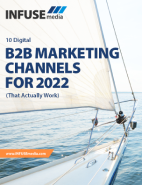

#4 Microsoft 365 for Business
The well-known office suite by Microsoft has a Business homepage with workshops to improve your skills.
Awareness (TOFU)
Microsoft 365 for Business has a simple homepage for its top of the funnel marketing, with little to see, yet enough to generate awareness in prospects.
Right at the start, there’s a “Help me choose” CTA, which asks questions about the user’s business and recommends a suitable Microsoft 365 plan. And there’s a video that showcases ambitious small business owners using the platform to grow their company.

If the user scrolls down, there are more videos: one showcases how Microsoft 365 boosts productivity, while the other focuses on cybersecurity.
Microsoft 365 blog
Another entry point for TOFU leads is the Microsoft 365 blog, which discusses product features and trends, such as the advent of hybrid work. These blog posts can be shared via social media and email to generate interest in the brand.
Consideration (MOFU)
Still on the homepage, Microsoft 365 has a comparison chart of its business plans, highlighting the price and features available in each.
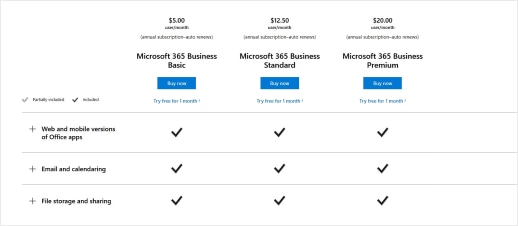
There’s also what Microsoft labels as “customized content” close to the footer, which includes whitepapers on Microsoft 365. These assets require the user to fill in a form, thus serving as MOFU content and as a lead generation opportunity.

Decision (BOFU)
Microsoft 365 for Business has case study videos on a non-profit, a social impact company, and a flower shop showcased at the bottom of its homepage (at the time of writing this article).
Since all three companies are widely different, it helps different buyer personas identify with the client’s problems and the solutions Microsoft 365 provided.
Right below the video, there’s a CTA to request a live demo. The prospect needs to fill out a form to schedule an appointment.

Brand evangelist content
Microsoft 365 links to its workshop environment from the homepage, which includes training and educational materials for professors.
These free live workshops are held with Microsoft Associates and act not only as a lead nurturing program, but also as brand awareness and evangelist content.
People see Microsoft as authoritative in tech, and will turn to its experts to earn certifications in coding and design. Also, Microsoft provides certificates for its products (such as Excel and Power BI), which are required by companies for certain positions.
Pros and Cons
Microsoft 365 for Business does a great job with its case studies and workshops, but needs to place the proper spotlight on its TOFU content.
Pros
- Brilliant case studies: Microsoft’s videos of their clients are well scripted, recorded, and edited. They have great quotes by interviewees and are perfect to be edited as ads for social media.
- Workshops for client retention: Anyone having issues with Microsoft 365 can take their courses instead of churning. Also, Microsoft makes it easy to get in touch with an authorized solution provider with a link on the homepage.
Cons
- Inaccessible blog: The blog has great content but isn’t readily accessible from the homepage, tucked away under a resources tab. Microsoft should create a section to highlight its blog right under the case study videos.

#5 Quickbase
Low-code platform Quickbase makes it easy for anyone to understand its services that allow you to develop apps with no coding experience.
Awareness (TOFU)
Quickbase has three articles that explain its core principles to newcomers:
All three explain the values (and features) of Quickbase to TOFU leads. And since the company believes in simplifying tech and empowering employees by launching apps without coding experience, these assets are awareness-building at its finest.
Quickbase also has a blog, which covers product innovation, digital leadership, and supply chain agility. These articles are written with TOFU leads in mind and ideal for sharing on social media and email.
Consideration (MOFU)
Like Salesforce, Quickbase splits its solutions by usage or industry for its middle of funnel leads.
And in both categories, Quickbase has dedicated pages that showcase the features, benefits, and pertinent case studies.
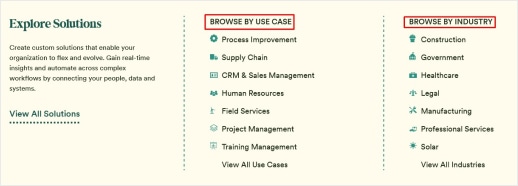
Similar to Samsung Business, Quickbase can funnel out prospects according to their needs and convert them on separate nurturing tracks. All pages have CTAs to start a free trial or demo, which means the company knows exactly what buyer persona the prospects fit into.
At the end of the solution pages, Quickbase empowers its users to choose how they want to use the platform.
This means a user that feels more confident in their abilities can learn immediately how to build Quickbase, while still offering support with “we’ll build it with you” and total support with “I want someone else to build it.” It’s a clever use of triple CTAs to yet again, funnel leads according to their needs.
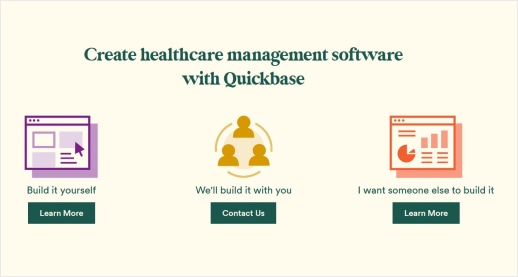
Decision (BOFU)
While Quickbase links to select case studies on its solutions pages, there’s a separate case study page under “Resources” at the top bar.
The case studies are written in the simple (yet effective) “challenge -> solution -> benefits” format, and some have videos to further illustrate how Quickbase solved the problem.
With a portfolio of over six thousand clients, there are non-profits, insurance companies, and even police department stories. It’s a treasure trove of BOFU content, and Quickbase can easily pick any case study that fits best with each lead.

Pricing and Enablement Services
Quickbase has a pricing page with three plans: team, business, and enterprise. The first option comes with a free trial, which can begin immediately, while the other two require filling out a form.
And below the plans, there are details on Quickbase’s Enablement Services, which also has a dedicated page with more information. With three options (Essential, Premium, and Ultimate) and a similar layout to the pricing page, Quickbase offers different levels of support for its platform.
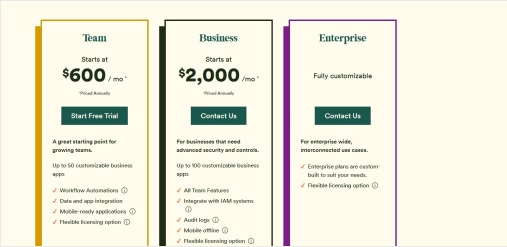
Pros and Cons
Quickbase provides a gold standard when it comes to sales funnel-optimized websites, with little to critique.
Pros
- High-quality content: Quickbase’s blog and explainer guides (such as What is Low-Code?) are expertly written and designed, making the subject accessible to experts and newbies alike.
- 90+ case studies: With almost one hundred case studies, Quickbase is by far the brand on this list with the most success stories to nurture MOFU leads and to showcase on social media.
Cons
While writing this article, we couldn’t pin down any cons on Quickbase’s part when it comes to sales funnels.

#6 Workday
This cloud-based management system showcases to prospects right from the start its benefits over legacy systems.
Awareness (TOFU)
Workday has a CTA for TOFU leads, “Why We’re Different”, which takes you to a page about how the company helps clients break free from Enterprise Resource Planning (ERP).
While it might seem like a MOFU page, it serves its purpose as an awareness-building tool by detailing the shortcomings of ERP and how Workday provides flexibility for agility and productivity.
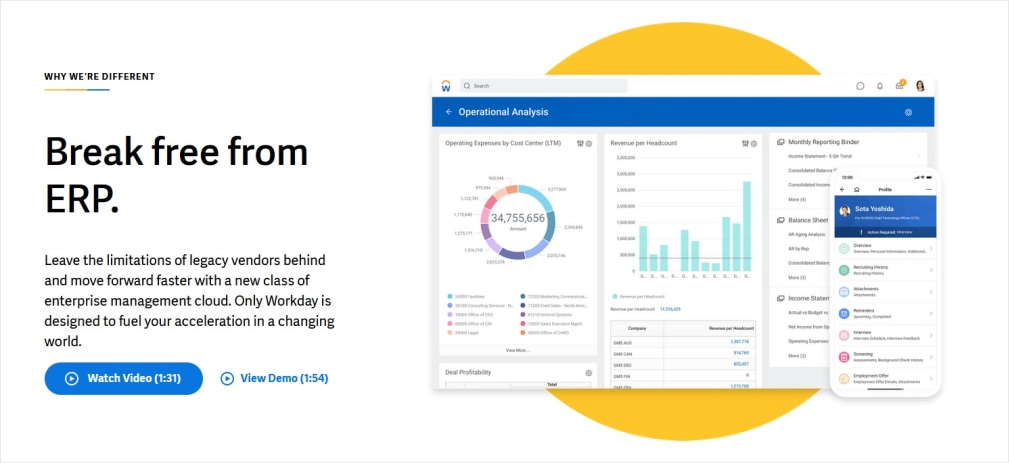
Workday blog
On its blog, Workday covers topics such as diversity, soft skills, leadership, and employee growth. These relate to Workday’s values, but also showcase their products’ benefits, as evidenced in this CFO technology article which discusses automation.
Also, it’s a gateway into Workday’s content ecosystem, which includes guides, webinars, videos, and podcasts.
Consideration (MOFU)
Workday has several entry points for its mid funnel marketing content, including a solutions tab which can be filtered by industry, need, organization size, and role (similar to Salesforce and Quickbase).
The solution pages highlight product features, include case study videos, and link to related resources. At the bottom of each page, there are CTAs to learn more about customer experience or contact sales.
The customer experience page serves as social proof, highlighting a 97% satisfaction rate, case studies, and the benefits of a long-term partnership with Workday.
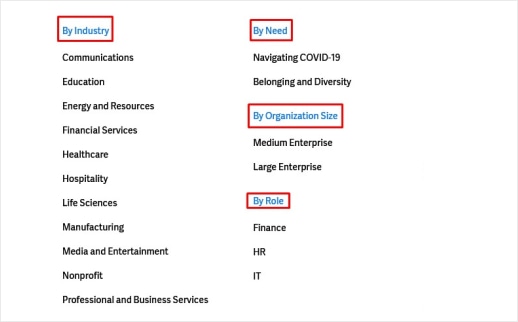
Enterprise resource center
Workday has a vast amount of assets for MOFU leads, allowing users to browse the content they prefer by industry, format, topic, or more filters.
This means a user can easily dive deeper into the solutions to their problems, as well as Workday’s features.
It’s a vast, branded library with assets to beef up any marketing funnel and nurture leads till they are primed to buy.
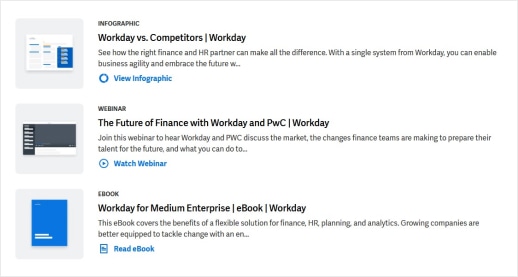
Decision (BOFU)
While the resource center is brimming with BOFU content, Workday has specific pages created for decision-making prospects.
One of them is Our Technology, where Workday explains how it’s a one-stop-shop for collecting and analyzing data, without any informational silos. There’s also an eBook that goes into the nuts and bolts of how the technology works, with enough details to satisfy a CTO.
Workday also has a Security and Trust page, which showcases how user data is encrypted and that every employee in the company receives security training.
Both of these in-depth pages have whitepapers that prove the value of Workday’s services, as well as a “Get Started” CTA to contact sales.
Pros and Cons
Cloud-based business management software Workday has enough guides to convince prospects why they should ditch ERP in its favor.
Pros
- Brilliant “Why Workday” content: The company has three long-form articles to explain Workday’s benefits compared to regular ERP platforms. The pages link to PDFs, datasheets, and product demos, and are great for MOFU/BOFU leads to decide what solutions to acquire.
- Vast resource center: Workday has more than enough assets to nurture leads no matter their vertical—and in several formats, such as eBooks, webinars, videos, and interactive demos. Thus, prospects can learn more about solutions according to their content preferences.
Cons
- Homepage short on TOFU content: Workday has brilliant guides for TOFU prospects, but should highlight some blog posts and awareness-building assets on their homepage to make them accessible.
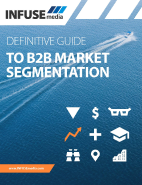

#7 Red Hat
Leading open-source enterprise Red Hat showcases its brand values and authority with its content marketing assets.
Awareness (TOFU)
Red Hat has a collection of these pillar pages to explain core subjects, such as Understanding APIs, which covers SEO-ranking questions like “What can you do with APIs?” and “What is API security?”
You can see all the pillar pages in the screenshot below:
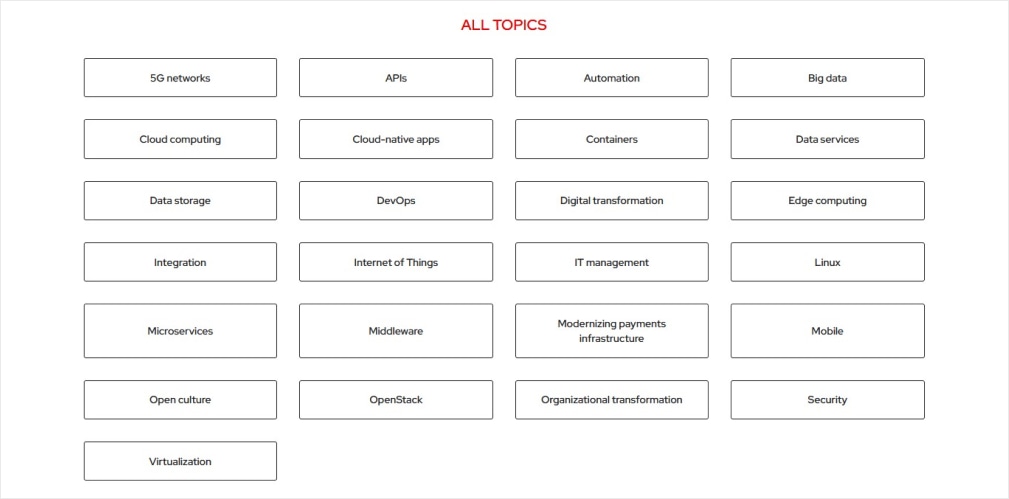
These comprehensive articles rank for SEO and can also be promoted on social media channels and email marketing campaigns to generate brand awareness.
Also, right at the start of the homepage, Red Hat links to Our Code is Open. This page explains its brand values and the benefits of open source services, which can be tweaked by clients to better meet their goals.
Consideration (MOFU)
For consideration-stage prospects, Red Hat has the Solutions tab in the top bar, which filters by solution, organization type, or customer.
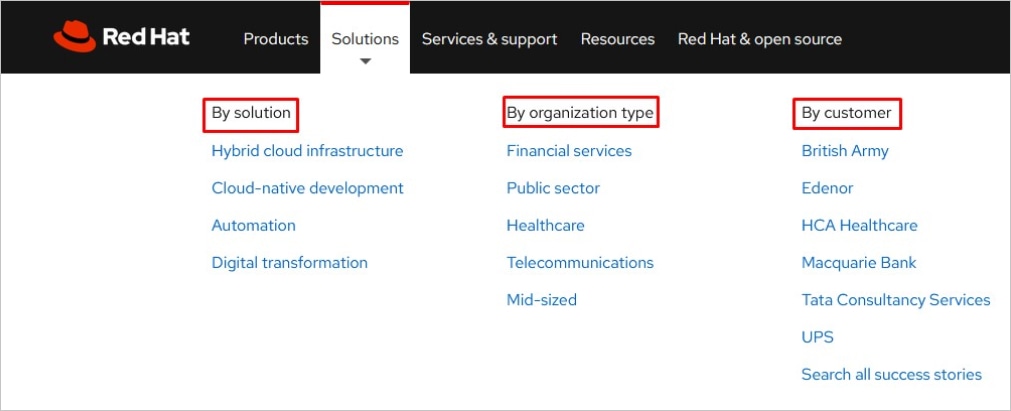
If you navigate by solution, such as Hybrid Cloud Infrastructure, Red Hat shows why Hybrid Cloud can solve the prospect’s problem, links to eBooks, and provides social proof with case study videos and client logos.
At the bottom of the page, Red Hat has three sections: Keep Learning, Get Trained, and Get Started. All its solution pages provide this structure for the prospect to easily identify where to get the information they need.
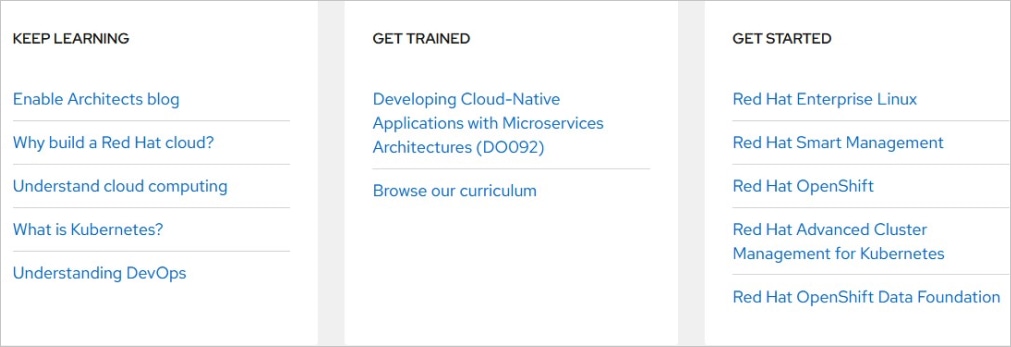
Prospects can also discover Red Hat’s solutions by organization or customer (case studies), which provide different points of entry for the consideration stage of the sales funnel.
Red Hat products and technologies
On the homepage, there’s an “All Red Hat products” section, which provides a brief description of each product in the company’s extensive portfolio.
While this is informative in itself, it's the link to Red Hat technologies after this section that provides content for MOFU leads.

Using the same five categories as before, Red Hat further elaborates on how its technologies can be used for cloud management, optimizing IT, and integrating apps.
Below the description of the technologies, Red Hat links to case studies and eBooks. The latter has a form, providing a lead generation opportunity.
Decision (BOFU)
Red Hat has a massive content ecosystem for decision-making leads. In fact, it's probably the stage of the funnel in which the brand has the most assets.
Firstly, the company has a case studies section (artfully labeled as success stories) with easy-to-read articles coupled with videos on each client.
Since the articles follow the same format (overview, challenge, solution, and results) it’s easy to skim through multiple clients in a single sitting. The videos are also brilliantly produced and an alternative to reading.
Additionally, Red Hat hosts a Resource Library, in which you find a treasure trove of digital assets, with new content published every four days (or even daily). There are analyst reports, overviews, datasheets, eBooks, infographics, and more (impressively, there’s even a 120-page eBook).
The amount of content can be overwhelming, but prospects can easily filter by format, topic, product, industry, or more.
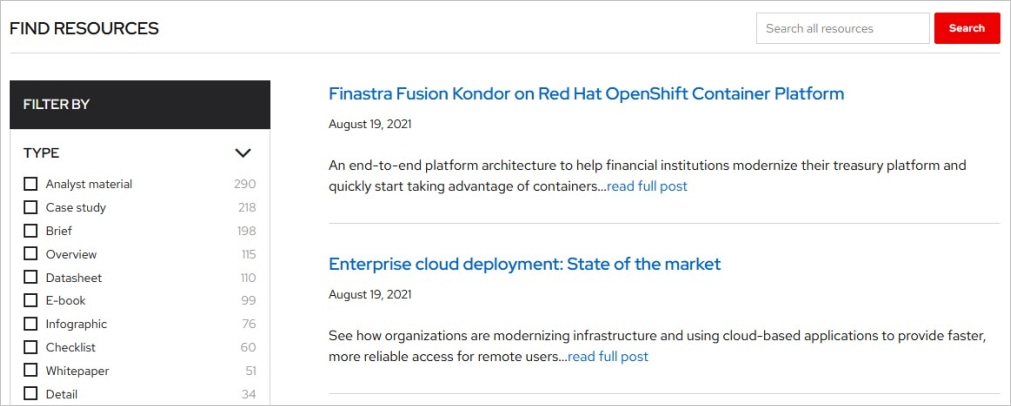
Red Hat events and blog
Red Hat also has plenty of on-demand webinars (labeled as events), on topics such as open hybrid cloud, Kubernetes, and automation.
Many are workshops in which attendees perform tasks supervised by Red Hat experts. It’s not only BOFU content, but also brand evangelist content since tech professionals see Red Hat as a reputable brand in open source enterprise solutions.
When it comes to the Red Hat Blog, the company shares the know-how of its staff with pieces on machine learning, IT operations, cloud-native architecture, and more.
The content is written by tech professionals for tech professionals, which might make the jargon inaccessible to others, but hits the nail on the head with its target audience as authoritative (and not as much as marketing, per se).
Brand evangelist content
Red Hat has annual events such as the Red Hat Summit, AnsibleFest, and Red Hat Forums, during which the community discusses innovations in open source tech.
For the virtual summit, Red Hat hosted breakout rooms where attendees could ask questions personally to staff—as well as Questlove, voice-over actor for Pixar’s Soul, to talk about storytelling.
The brand also has Training and Certification, which qualifies tech professionals to use Red Hat’s products. There are free, on-demand courses, and paid certifications with hands-on tasks.
Another brand evangelist space is Red Hat’s community, with separate portals for open source advocates, system admins, IT leaders, and architects. These portals feature Red Hat staff and members from the wider tech community, creating a space for debate and learning (while also promoting brand awareness).
Pros and Cons
Red Hat promotes authority with its content and a suite of pillar pages for beginners to learn about open source.
Pros
- Huge suite of BOFU and brand evangelist content: Red Hat has an arsenal of content for decision-making prospects, from on-demand events to lengthy eBooks and analyst reports. The Red Hat Summit and training courses provide value for clients, guaranteeing their continued, long-term use of Red Hat’s products.
- Pillar pages: Red Hat has pillar pages for 24+ tech topics, which educate TOFU prospects and rank on the SERPs.
Cons
- Mismatch of gated and ungated content: Some brilliant content by Red Hat isn’t gated (such as the Organize for Innovation eBook), which seems like a lost opportunity to generate leads. Red Hat should take advantage of its high-quality assets by gating them.
- Non-amateur-friendly training and resources: Red Hat writes most of its content for experts, which might alienate people dipping their toes into the industry. Perhaps creating an area with content for beginners would solve this problem. However, it is important to consider that amateurs might not be Red Hat's ideal client profile (ICP). As such this would be a strategic choice for the company.

#8 SAP
This leader in business management tech has an authoritative blog and dedicated knowledge centers for each industry vertical.
Awareness (TOFU)
SAP has an “Industries” tab in the top bar, which, similar to other companies in this article (such as Salesforce), allows the prospect to access a comprehensive page with solutions for their industry.
Each page details SAP’s benefits for that particular industry, with the jargon changing appropriately. For example, while the Insurance page mentions omnichannel, sales force, and claim lifecycle, the Building Products page is more direct, simply listing SAP’s solutions.
Thus, SAP adapts its messaging effectively to each buyer persona, toning up the jargon when necessary, but keeping things simple for a less tech-savvy reader.
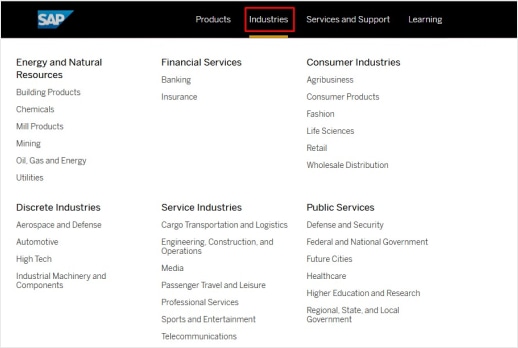
The industry pages also link to case studies for social proof and whitepapers most related to that niche.
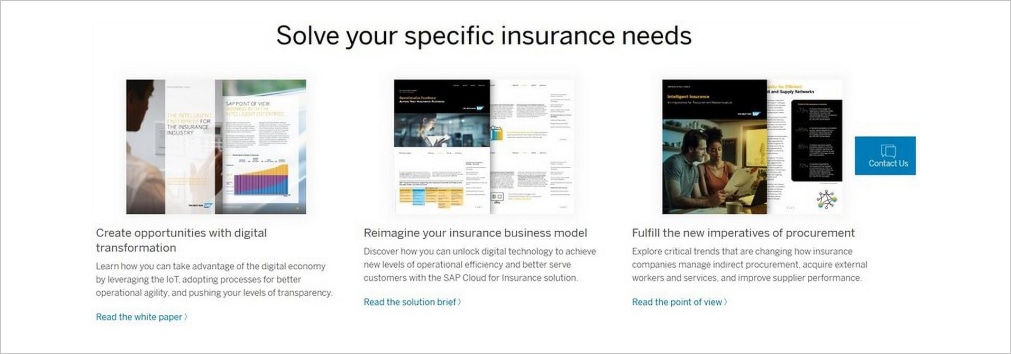
SAP also presents a roadmap with the highlights of the current software release for that industry, the upcoming innovations, and future plans. This helps the prospect see the future value of acquiring SAP, since updates are already planned in advance.
Some pages also include quotes by analysts on trends and the results by companies that digitize their operations, such as an 8% increase in customer satisfaction with financial companies that use SAP.
SAP Insights
SAP has an Insights blog where it publishes thought leadership, exclusive research, and “what-is” guides that teach basics in tech.
On its “About” page, you find out what SAP Insights is all about:
“We promise no sales pitches. No marketing fluff. No 'insider' technical jargon. Just compelling insights about business and technology.”
That’s quite the promise, and SAP keeps it. Research, such as this piece on the passionates (a target audience that cares deeply about social causes), can’t be found anywhere else, and is well-written and designed. Above all, it is content that shapes the opinions of executives in multiple industries, since SAP is used by several verticals.
In fact, SAP cares so much about this demographic that it even has an original series, with episodes that cover social causes and business, such as social-conscious sports and fashion.
And the company blog has a “Fundamentals” category with “what-is” and “how-to” content, along with tips for effective business management. The “what-is” articles rank for SEO and explain core tech topics in simple language, such as What Is Enterprise Performance Management (EPM)?
With this type of content, SAP not only informs TOFU prospects, but also positions itself as an authority when it comes to business management and technology.
Consideration (MOFU)
Similar to other companies on this list, SAP uses the Products section in the top bar to funnel out solutions for its mid funnel marketing.
Like the Industries tab for the TOFU prospects, SAP splits its products by vertical. Then prospects can either click on the vertical (such as ERP and Finance) or on each product separately to learn more.
These product pages focus on the benefits of using SAP and feature case studies and analyst reports. While it is possible to read a full list of products by clicking on “View our portfolio”, SAP prefers to use videos and infographics to show value to the prospect.
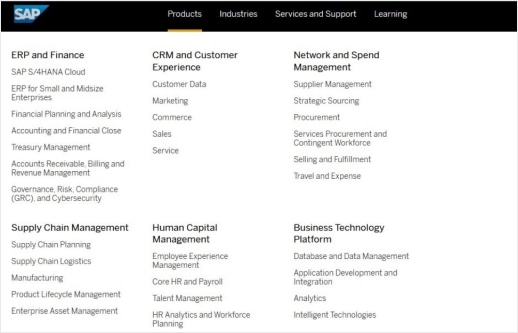
Knowledge Center
On the product pages mentioned above, SAP highlights a “Knowledge Center” in the navigation bar:

Each industry has a knowledge center, with curated insights from SAP’s blog, as well as videos and whitepapers. This section is perfect for MOFU prospects to get their fill of consideration-phase content to advance to the end of the funnel.
Decision (BOFU)
SAP highlights on its homepage some solutions, such as RISE with SAP and its Customer Data Platform. It is also possible to access products via the top bar, with icons clearly setting them apart from the MOFU-stage product lists we mentioned before.
These pages list the benefits and features of the products and usually link to further resources, to learn more, such as analyst reports, case studies, or even a product demo. Instead of maintaining the same format for all product pages, SAP keeps a dynamic layout and links to resources when appropriate.
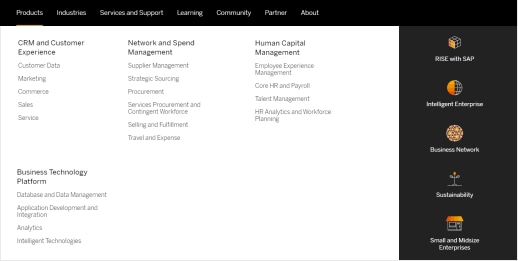
Case studies
SAP has a plethora of customer stories, in either video or text format. Some are even published in reputable news outlets, such as the Cargill case study in Forbes.
At the time of writing this article, SAP highlights its case study of soccer club FC Bayern Munich and how it uses its Customer Experience platform to engage supporters and drive stadium attendance and merchandise sales.
The brand knows how influential it is globally and makes this clear at the start of its dedicated customer stories page with the following copy:
“SAP customers represent 98% of the top 100 most valued brands in the world.”
You can’t provide better social proof than that. And with over 10 pages of case studies with a healthy mix of video and text content, BOFU prospects can browse at their leisure the content that interests them most.
And a convenient top bar makes browsing easy, by categorizing the case studies by industry, product, topic, region, or company size.
SAP Learning and Community
SAP provides an extensive learning center for its clients, with individual and team certifications available. Thus, a client can acquire one of its products with the peace of mind that its staff can be trained to use it efficiently.
And the offerings vary from free online courses to official SAP global certifications that staff can showcase on LinkedIn to prove mastery of the product.
Thus, SAP provides leeway for prospects to choose how they’d like to learn, whether through a podcast, on-site training, or an official examination.
And when it comes to the SAP community, it's thriving with forums and blogs in which users help each other out with troubleshooting. Since SAP products are complex, with a big learning curve until mastery, it makes sense to create a branded community space for asking questions.
Pros and Cons
SAP has a Knowledge Center and an Insights blog to read up on management and tech, yet leaves TOFU prospects a bit lost when visiting its homepage for the first time.
Pros
- High-quality blog: SAP’s Insights blog features brilliant SEO content, as well as thought leadership in the form of unique analyst reports and commentary on trends in the industry. The brand has one of the best blogs on this list.
- Dedicated product pages with a knowledge center: Since SAP’s offerings are hard to understand at a glance (or even skim through), the brand makes it easy for prospects to find the products most relevant to their industry, and find all the resources they need from a knowledge center.
Cons
- Too many pathways on the homepage: SAP doesn’t funnel out prospects via its homepage and relies solely on the top bar for this task. The brand could redesign its homepage with icons to select products per vertical, rather than focus on them alone (for example, what does RISE with SAP mean for a TOFU prospect?).
- Mismatch in asset formatting: Some case studies are in a PDF format, others link straight to a news article, and some are written as long-form blog articles. This mismatch happens in the dedicated Knowledge Center for each industry too, with content jumping between gated (requiring an SAP account) to ungated posts on the Insights blog. This could be remedied by establishing a standard for all content that’s featured on product/industry pages.

#9 Oracle
Big tech corporation Oracle has an impressive university for educating its clients and what-is pillar pages for TOFU prospects.
Awareness (TOFU)
Oracle has a “Learn” section with SEO-ranking articles on queries such as “What is Cloud Computing?” and “What is Docker?”, which inform TOFU prospects on the technology behind the brand's products.
These pillar articles are written in layperson terms, which means even prospects that aren’t familiar with tech can understand these key concepts.
Thus, Oracle successfully builds awareness for users searching these terms on Google. They are also the perfect assets to share via email and social media, or promote with ads.
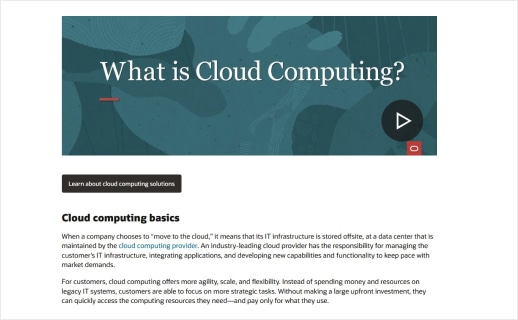
Oracle Blogs
Oracle has 17 blogs (which function more as categories) for several industries, such as Human Capital Management and AI & Data Science. There are also blogs for Diversity, Corporate Citizenship, and Careers.
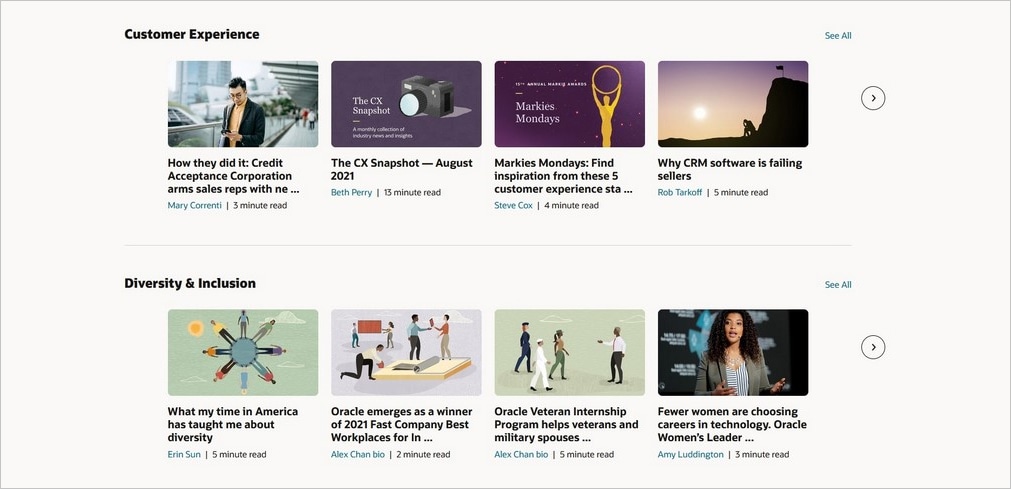
The blogs include thought leadership posts by Oracle staff, as well as “how-to” articles and numbered lists. Content such as How to encourage career development in your staff is ideal for TOFU leads to become aware of problems (lack of career development) and solutions (goal-planning, mentoring, etc.).
Consideration (MOFU)
Similar to other companies on this list, Oracle uses the top bar to filter out solutions based on industry:

These links go to dedicated industry pages with highlights of Oracle’s results in that vertical (such as its usage by the top 20 global communications providers), case studies, and the benefits provided by Oracle products.
The blogs also play a role in the industry pages, with curated posts for that vertical, as in the case of Communications in the screenshot below:

These blog posts cover news in that vertical with commentary by Oracle staff, serving not only as consideration-phase content, but also as thought leadership.
Oracle also links to exclusive reports when applicable, such as this document on virtual assistants on its automotive industry page.
Decision (BOFU)
Oracle’s BOFU content is by far its most robust. The homepage itself is designed with the bottom of the funnel prospect in mind, with products split between Oracle Cloud Infrastructure and Applications:

Clicking on the categories leads to a navigation menu with all the products and featured case studies.
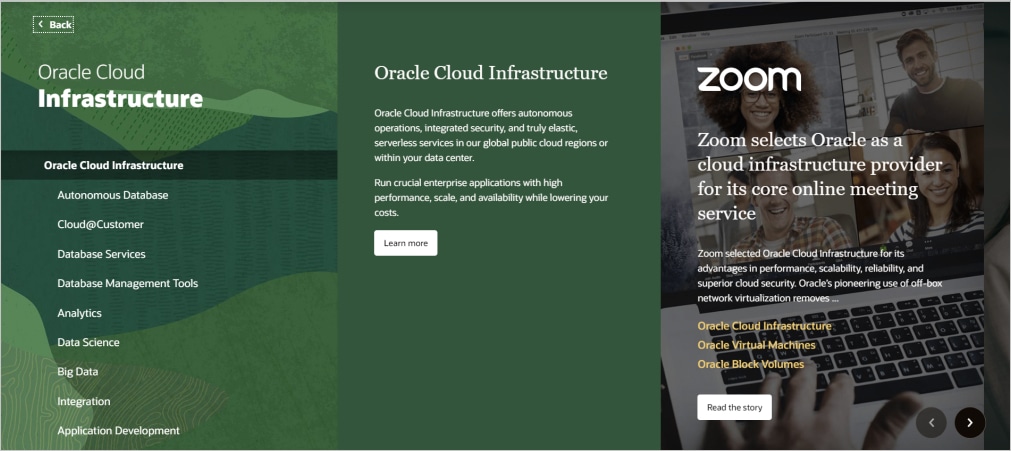
If the prospect decides to click on “Learn more”, they’ll head to a comprehensive product page, detailing the benefits of the solution, along with PDFs and recorded demos. The other option is the case study, which is usually an article (sometimes including a video).
In its Zoom case study, Oracle showcases the client’s challenge to keep up with the rise in demand from distributed workforces during the pandemic, and how Oracle engineers adapted its system to meet this demand in only nine hours.
Oracle doesn’t maintain this “challenge -> results” format in all its case studies, however. Some are written as long-form articles, such as this piece on Western Digital and how it consolidated data from three companies with Oracle ERP.
Products (mega-menu)
Another, more direct, point-of-entry for BOFU leads is their mega-menu, which also splits Oracle’s products per category, but requires no navigation and doesn’t feature the case studies.
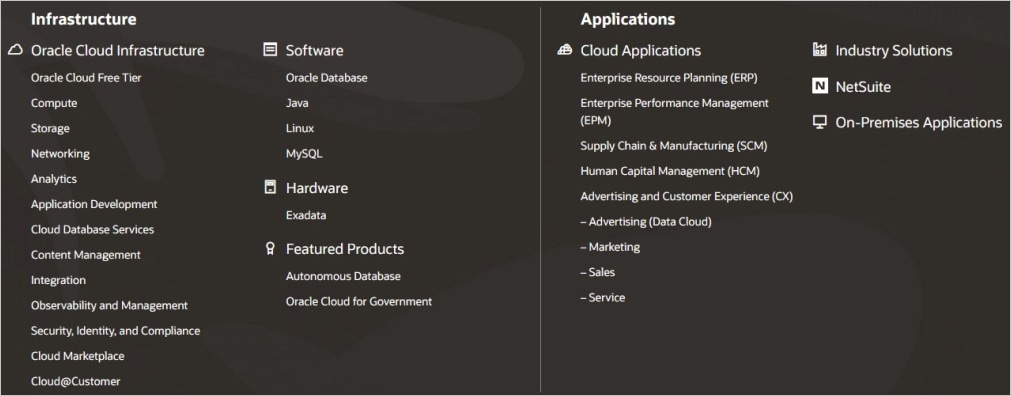
This is a quicker way for decision-making prospects to read up on Oracle’s solutions, with dedicated pages that list the benefits and include CTAs for pricing.
Analyst reports
Oracle has a page dedicated to reports by Gartner, Forrester, and the International Data Corporation (IDC). The reports are organized per product category, industry, and corporate.
The reports cover Oracle’s products, which not only help the prospect make a decision, but also serve as social proof of its results.
Oracle University
Oracle has an ecosystem for onboarding new clients, as well as building brand loyalty. For starters, Oracle University is a free platform (with some paid classes) for professionals to be certified in Oracle Cloud products, such as its Human Capital Management (HCM) and ERP.
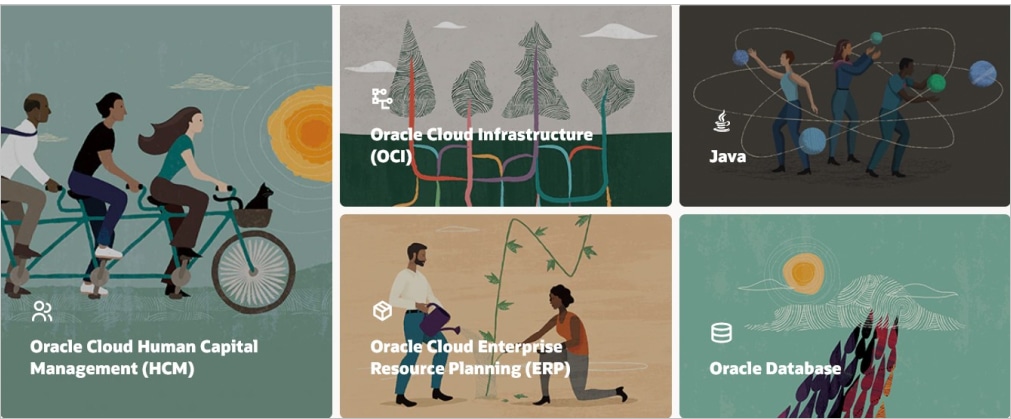
Each learning path contains a preview of its modules and the estimated time for completion. Oracle also offers private training with courses personalized to the client’s needs and a tutor that can go on-site for the lectures.
Events
Oracle has a suite of virtual events, including four product-focused summits (CX, ERP, HCM, and Cloud Platform), which include webinars with Oracle leaders and other key players, such as this Diversity panel with leaders at Schneider Electric and Fujitsu.
Apart from these summits, the company also has Oracle Live, which are company announcement webinars; Customer Spotlight (live case studies); and Developer Live, with hands-on panels by Oracle developers on tech.
As you have probably noticed, these events are designed for Oracle clients, to keep them engaged and informed of its products. Thus, the brand builds a community and fosters loyalty.
Pros and Cons
Oracle has plenty of content for BOFU prospects, but doesn’t prioritize awareness-stage leads on its homepage.
Pros
- Comprehensive learning and events suite: Oracle has a learning path for anyone to master its products, and a constant stream of webinars to engage its clients. The live summits also cement Oracle as a thought leader when it comes to tech, maintaining its role as a leader in the industry.
- A treasure trove of BOFU assets: Many brands struggle to create bottom of the funnel content, listing only a few case studies and reports, but Oracle goes the extra mile, with endless case studies, reports, and blog posts.
Cons
- No direct point-of-entry for TOFU prospects on the homepage: Oracle’s homepage is geared towards MOFU and BOFU, with only a learning center in the footer and its blog for awareness-stage prospects. Oracle could redesign its homepage to include this learning section at the top and give it more visibility.
- Non-gated content: Oracle doesn’t gate its webinars and analyst reports, a missed opportunity for generating leads.

#10 VMware
Cloud computing and virtualization enterprise VMware caters to all marketing funnel stages with its user-friendly homepage.
Awareness (TOFU)
For top of funnel prospects, VMware has a glossary of tech terms. This can be accessed via the “Resources” tab of the top bar, with specific terms showcased, such as Cloud Migration and Hyperconvergence.
The terms are explained in beginner-level language (adequately so), sometimes include videos, and feature gated assets such as guides for beginners to learn more.
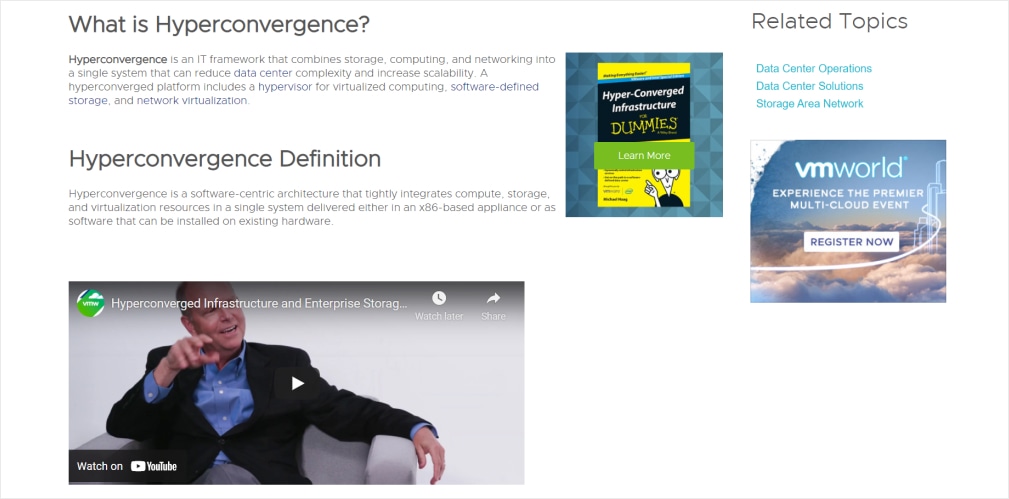
This provides an opportunity for VMware to generate leads and nurture them with email for its mid funnel marketing campaigns.
By industry
Another point-of-entry for TOFU prospects is “by industry” in the top bar.
Each link leads to a dedicated page, listing the benefits of VMware for that industry.
On the Higher Education page, for example, there’s a video with IT professionals at universities explaining how VMware provides secure connections for faculty and students, along with 24/7 access to content.
It also links to blog articles on trends and focuses on the solutions (rather than the products). For example, one section reads “Empower Students, Faculty and Staff with Digital Experiences” and then mentions how the brand’s SaaS and cloud solutions can secure access from any location.
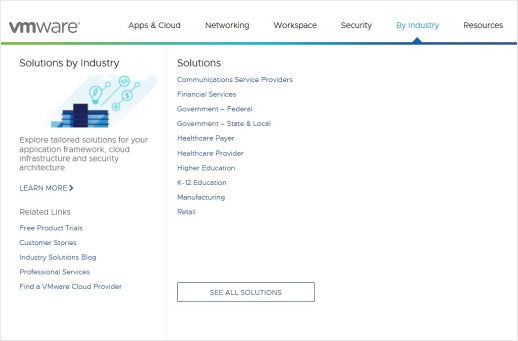
Consideration (MOFU)
In the top bar, prospects can easily find solutions under each of VMware’s categories (Apps & Cloud, Networking, Workspace, and Security) and click on a page to learn more.
There’s also a “See All Solutions” CTA, which leads to a page with VMware’s 49 solutions across all four categories.
And like the industry pages mentioned above for TOFU, the solutions are focused on the benefits rather than VMware’s products. Therefore, the prospect has a clear view of what will improve in their organization.
For example, Anywhere Workspace Solutions showcases the benefits (such as “manage multi-modal employee experiences”) and links appropriately to infographics, videos, and a whitepaper to learn more.
This format is adopted across solution pages by the company, making it easy for a prospect to browse through pages to find what suits them best.
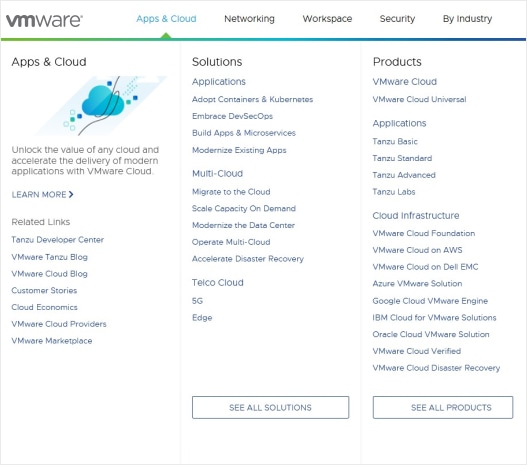
Why VMware?
On the homepage, VMware has a clever “why?” section with, three reasons to pick the company for your tech needs:
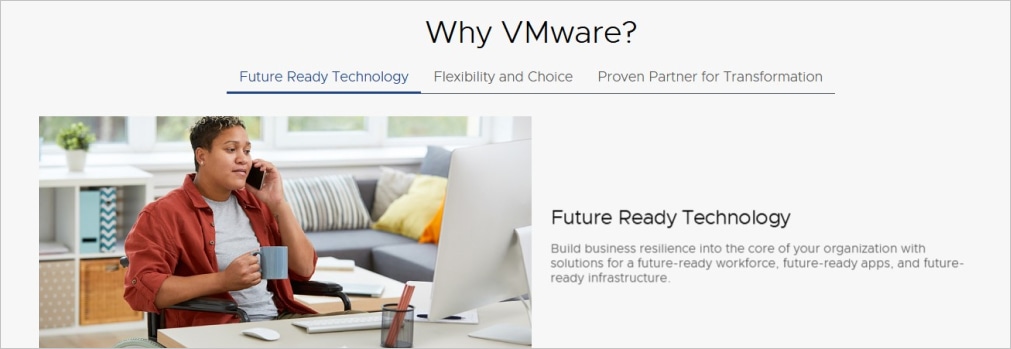
These straight-to-the-point reasons serve as unique value propositions (UVPs) and are conveniently placed right above the case studies for proof of those claims.
VMware blogs
With dedicated blog categories aligned with the company’s solutions (Cloud, Security, Digital Workspace, and Modern Apps), VMware publishes a regular stream of content—almost daily—with posts written by staff or guests.
This post about SD-WAN (a VMware network solution) is written by a guest who uses it, thus providing more credibility than if the brand wrote it themselves.
Decision (BOFU)
To continue our train of thought from the previous section, VMware highlights its case studies at the bottom of its homepage.
This is the ideal placement for this type of content, since the prospect will read through the benefits and solutions before heading to these decision-making assets.
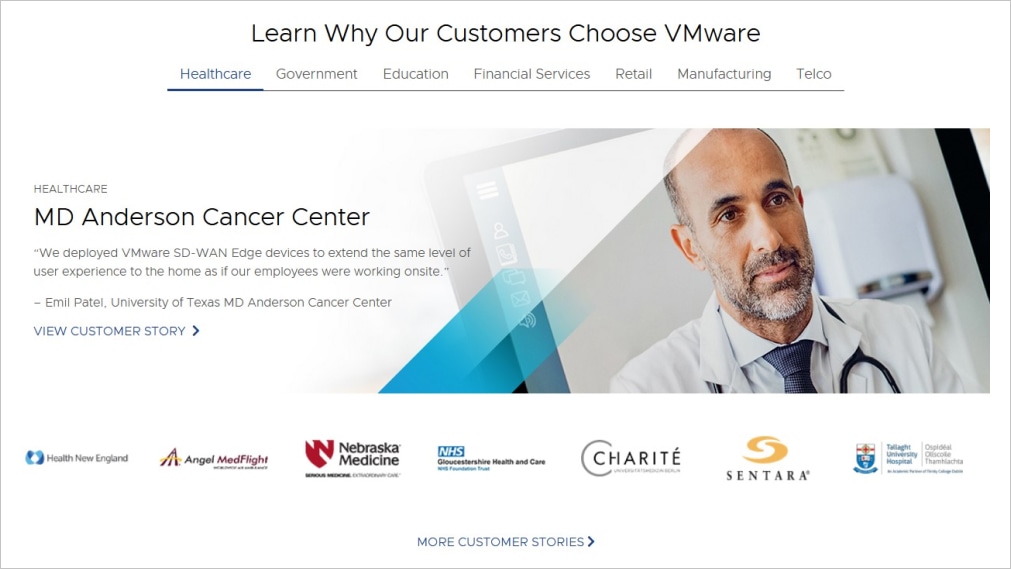
Split by industry, the section features quotes, a headshot, and a link to read up on the case study. This makes it easy for the prospect to decide at a glance what story they identify with the most.
The case studies are either in PDF (MD Anderson Cancer Center using VMware for remote work), a video (Government of Tyler, TX aiming to become a smart city), or a long-form article (DICK’s modernizing its omnichannel experience).
Products (top bar)
VMware also has a point-of-entry for BOFU prospects in its top bar, which you can navigate per subcategory or a stand-alone product:
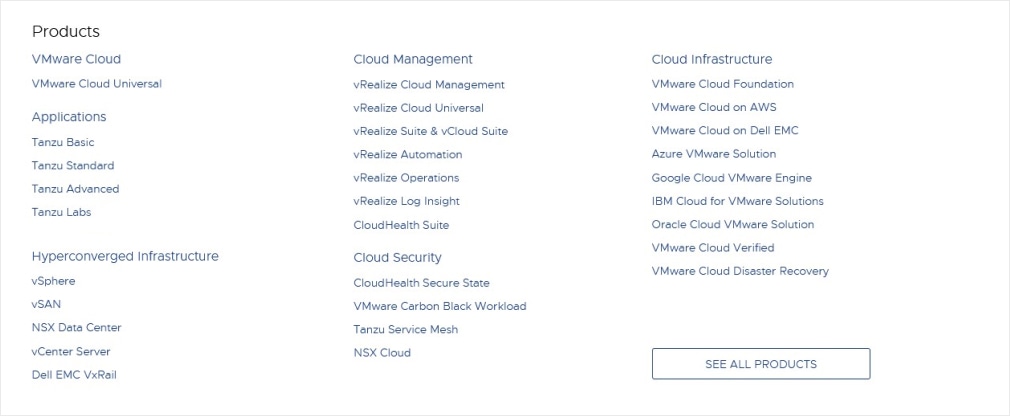
As you can see in the screenshot above, it’s possible to navigate per subcategory (VMware Cloud, Applications, etc.) or product (Tanzu Basic, Oracle Cloud VMware Solution, etc.).
The subcategory product pages give an overview of the benefits of using the products, whereas the standalone pages get into the nitty-gritty of the features with FAQs, datasheets, and pre-recorded demos.
VMworld
The company has a virtual summit with its staff as keynote speakers on three topics: Multi-cloud, End-user services, and Security.

The conference’s web page features some speakers, but also allows the prospect to view all events. This leads to a plain-text list of all the events (which looks a lot like a university portal) and an option to “add to schedule”.
The other (easier) choice for prospects is to simply click “register now” for the whole summit, as in the screenshot below:

Pros and Cons
VMware has brilliant case studies and an easy-to-navigate solutions menu.
Pros
- Full-funnel homepage: VMware’s homepage has points of entry for TOFU, MOFU, and BOFU prospects, which makes it easy to advance between marketing funnel stages and consider solutions towards a purchase.
- Case studies: The brand’s case studies are well-designed, with eye-catching quotes and high-quality videos.
Cons
- Gated content mismatch: Like other brands on this list, VMware doesn’t standardize when content is gated (or not). The assets for the TOFU glossary are gated, whereas the case studies are not.
Final Thoughts
After a rundown of all 10 brand websites, here are some takeaways on how to integrate a sales funnel into a website:
- Sections for TOFU on the homepage
Some brands on this list don’t prioritize top of funnel leads, which is where the buyer’s journey begins. Many companies featured in this article have assets for these prospects, but hide them in the footer (such as Oracle).
Brands that wish to build a sales-funnel homepage should create a section with awareness-building content, featuring blog highlights, pillar pages, or even a video.
- To gate or not to gate?
Five companies on this list (including VMware and SAP) haven’t standardized their content when it comes to lead forms, which means lost opportunities for lead generation. Brands should determine what types of assets are gated and make sure that standard persists across its content marketing funnel.
- Video case studies
Most of the case studies on this list feature a video. Video content provides more credibility to client stories, since they talk for themselves about the company’s results. In fact, video is one of the most effective ways to promote a B2B company.
Thus, video case studies are an engaging asset that you should invest in. Another option is to create long-form articles, like VMware’s case study of DICK’S.
- Learning Center
A virtual suite of workshops, webinars, or certification courses promotes brand loyalty and authority in your industry. Also, as mentioned before, it reduces churn and client frustration, since staff can be onboarded with these training materials.
- Filters for content by niche
Many brands on this list filter content by industry/need, so the prospect views content that resonates with them.
The pages include copy and offerings tailored to the buyer persona, as well as separate lead nurturing tracks with unique CTAs.
- Pillar pages
From an SEO and lead funnel perspective, pillar pages work wonders for a brand website. Thus, invest your time in content for common “What-is” questions, or even a glossary of terms to teach jargon to TOFU prospects.
Need help creating assets for the TOFU, MOFU, and BOFU stages?
This lead nurturing playbook explains what types of content work best as your lead progresses from the awareness to the purchase stage in their buyer’s journey.
The playbook also showcases a 5-step sales funnel, which adds two steps to the MOFU stage (“Interested” and “Active”), so you can track lead nurturing with more clarity.










